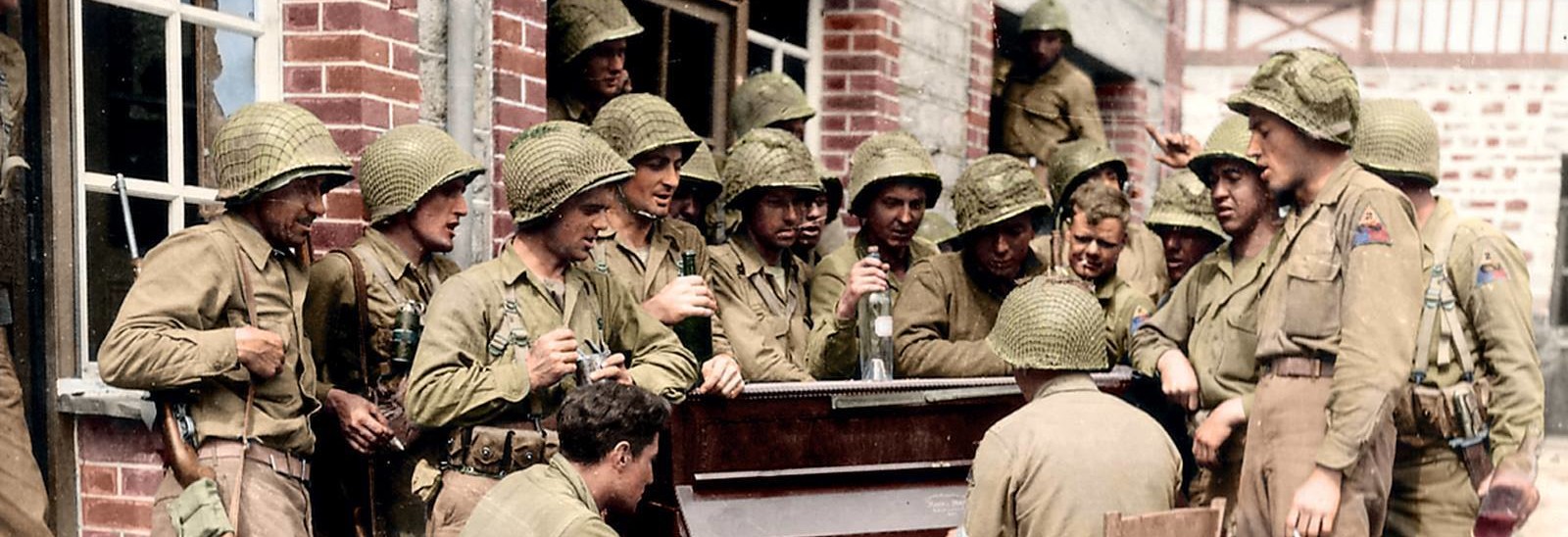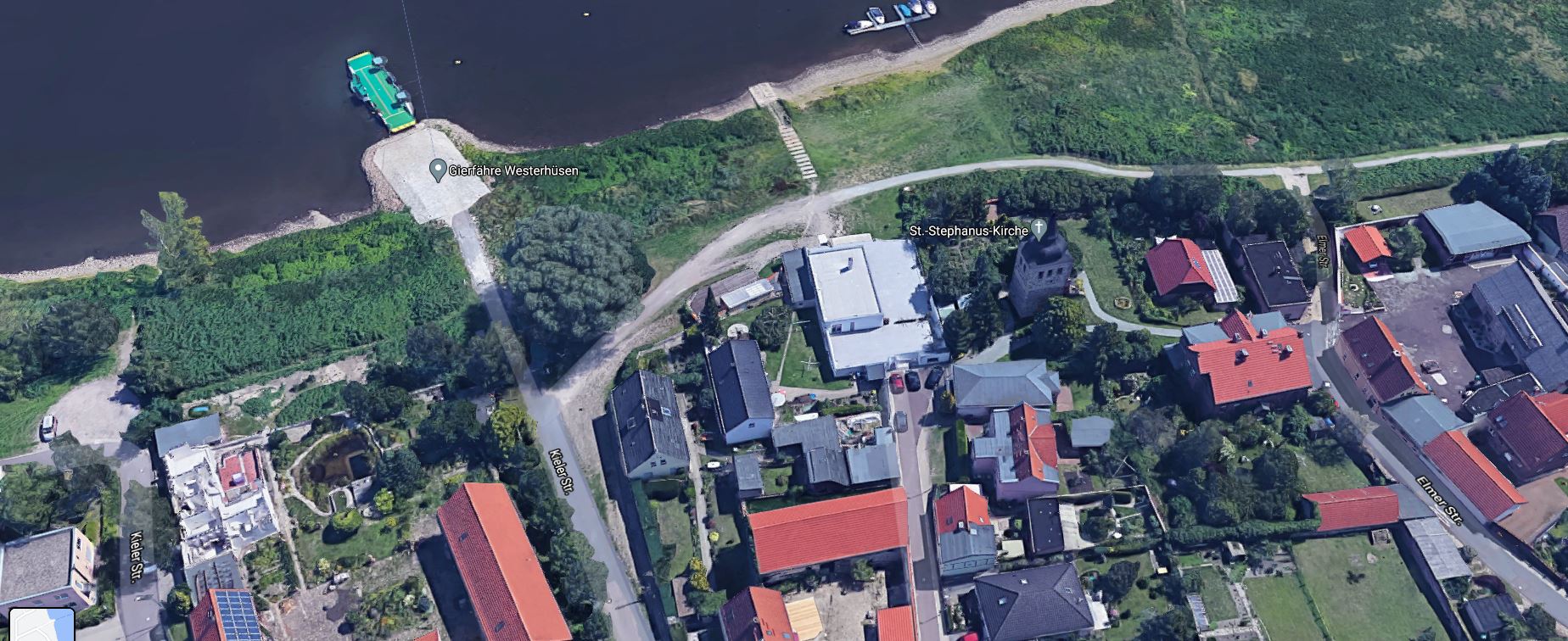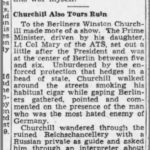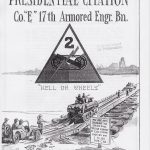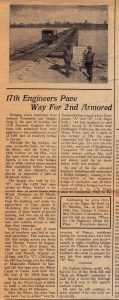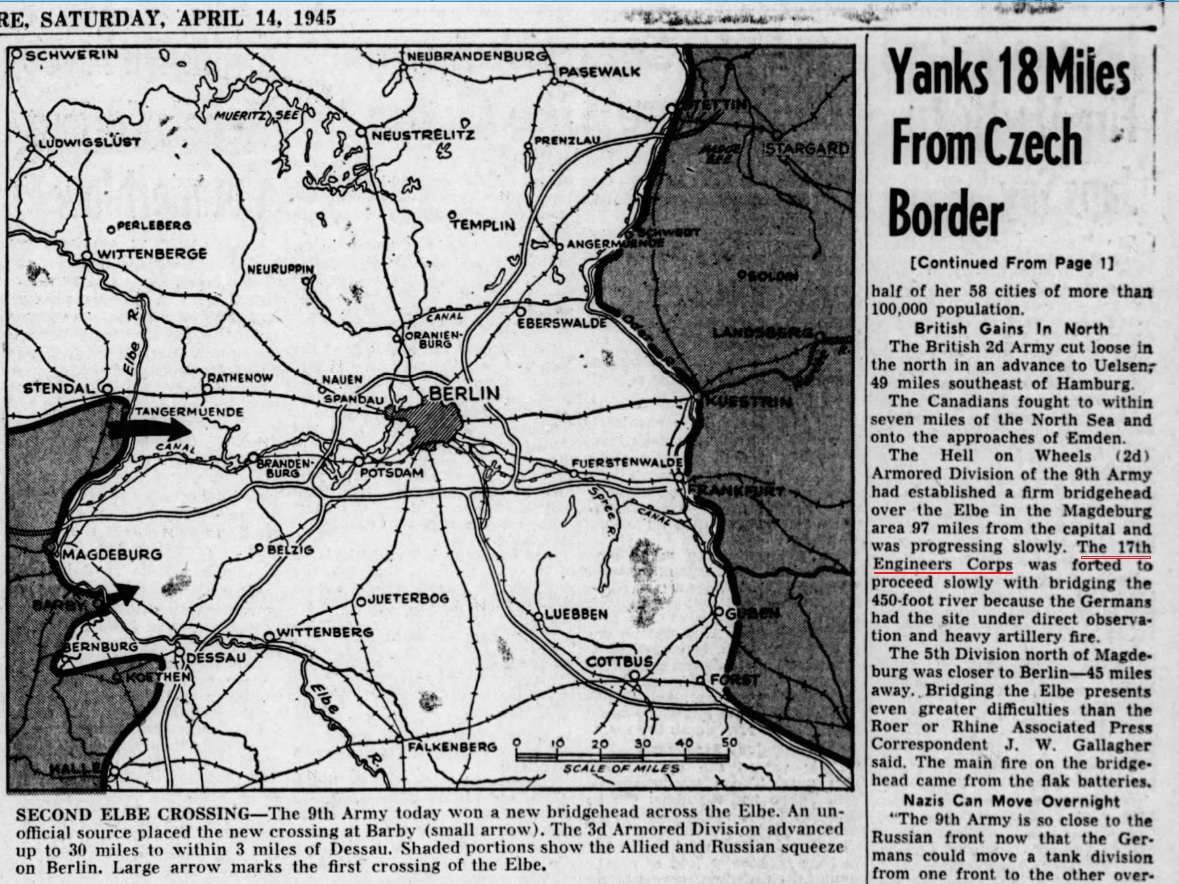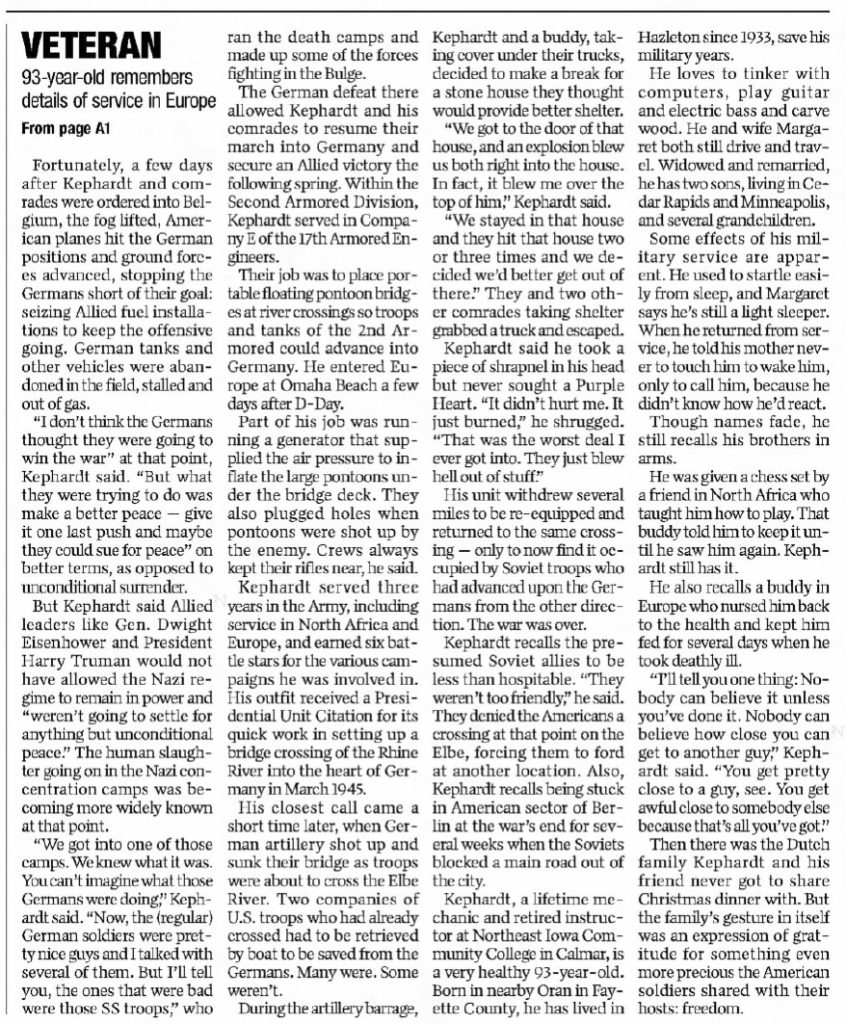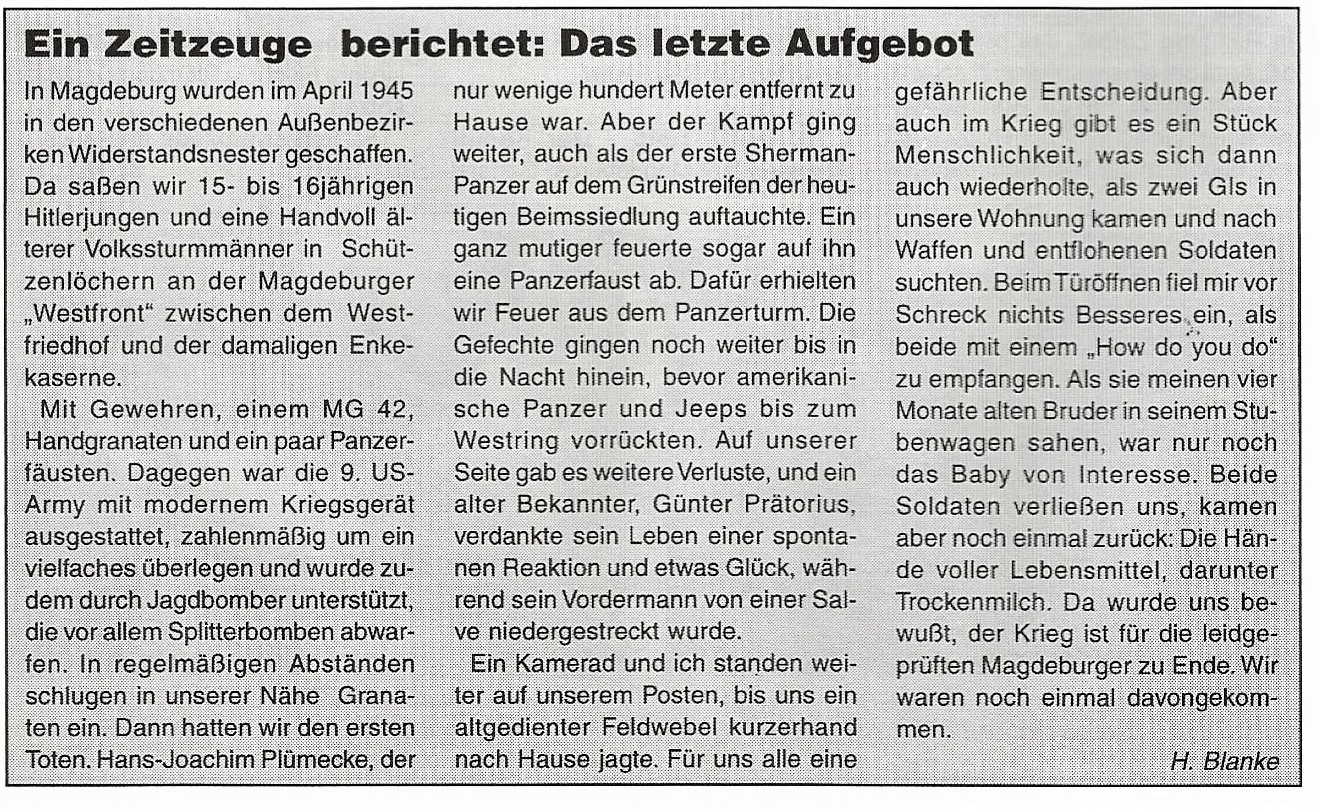12-2020
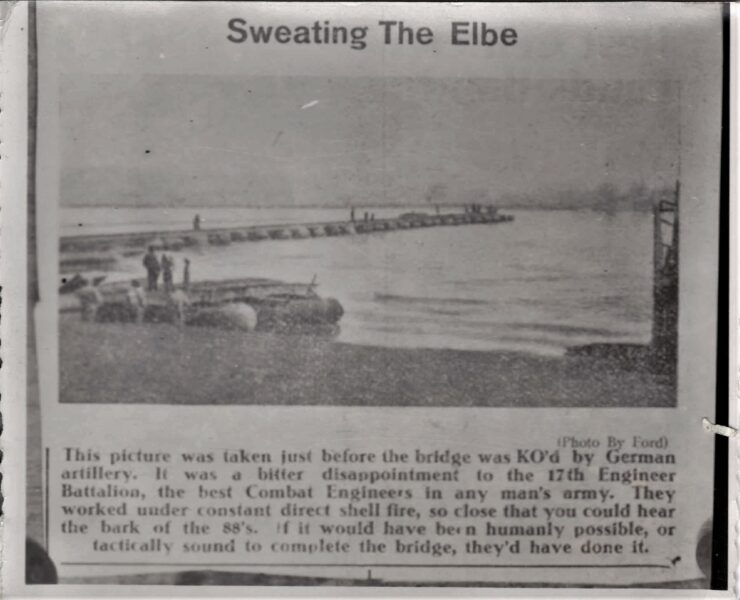
Technical Sergeant Gordon J Ketchpaw; “Bridge across the Elbe before it was destroyed” April 13 – 14, 1945 (Courtesy: Dave Ketchpaw)
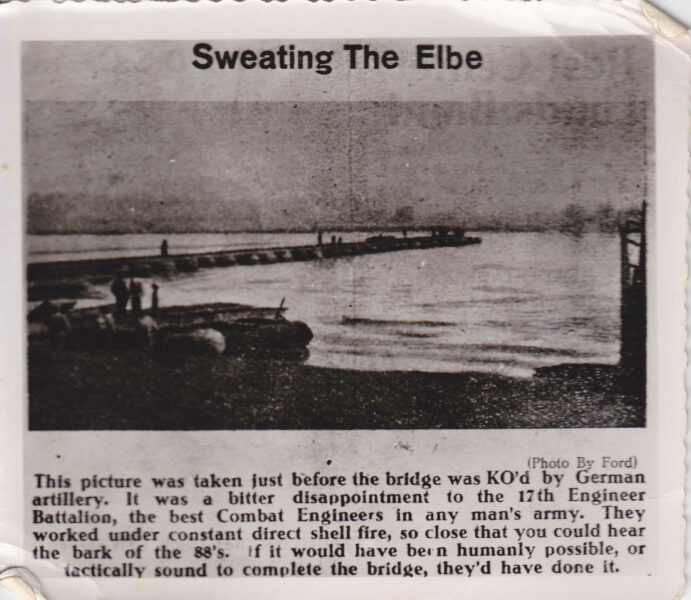
Technical Sergeant Gordon J Ketchpaw; “Newspaper article, Bridge across the Elbe before it was destroyed” April 13 – 14, 1945 (Courtesy: Dave Ketchpaw)
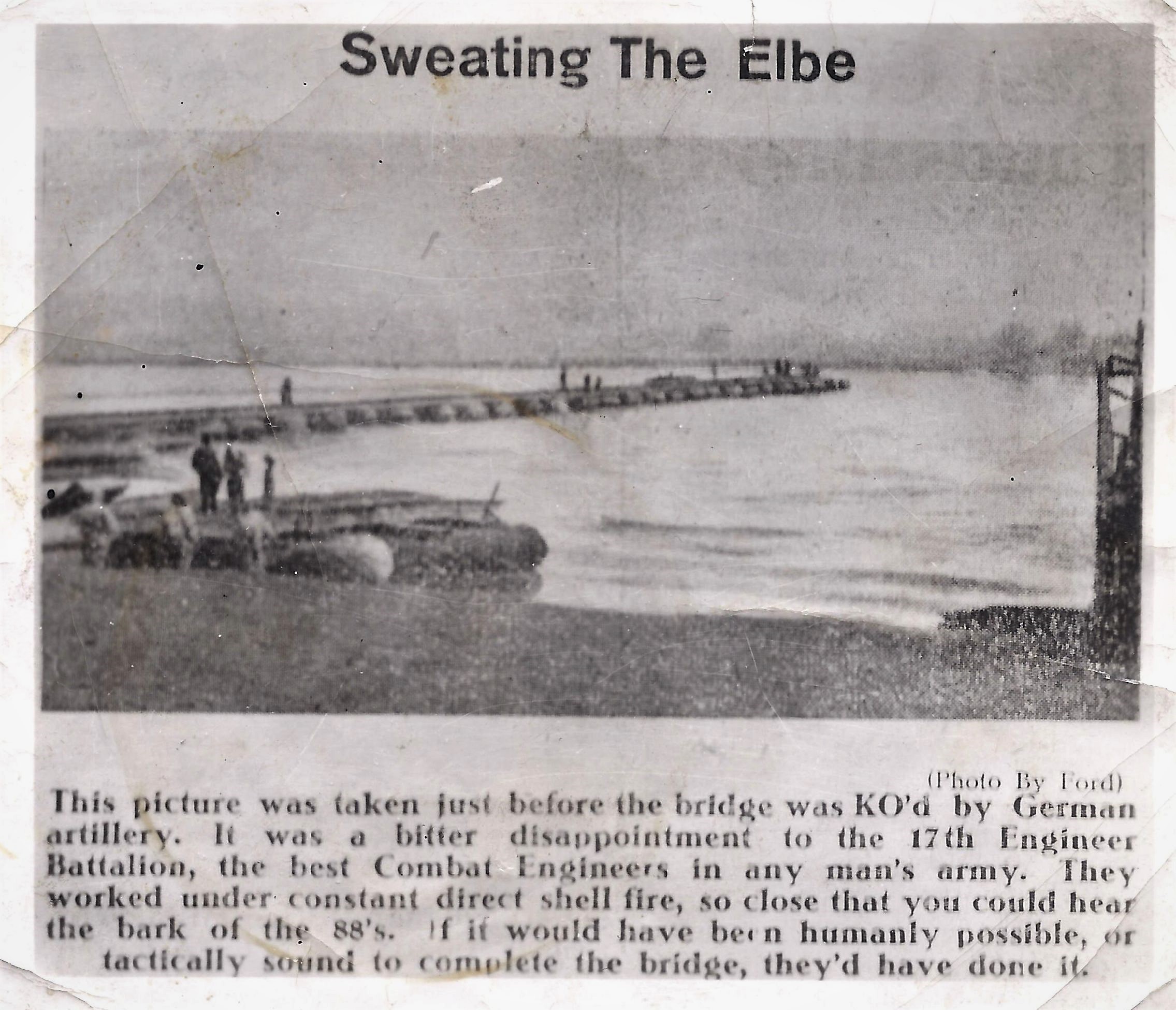
Bridge across the Elbe river before being shelled by 88’s on April 14 -15, 1945. (Photo owner: Benjamin Heylen
ASBL Musée du Souvenir 40 www.museedusouvenir.be
11-2020
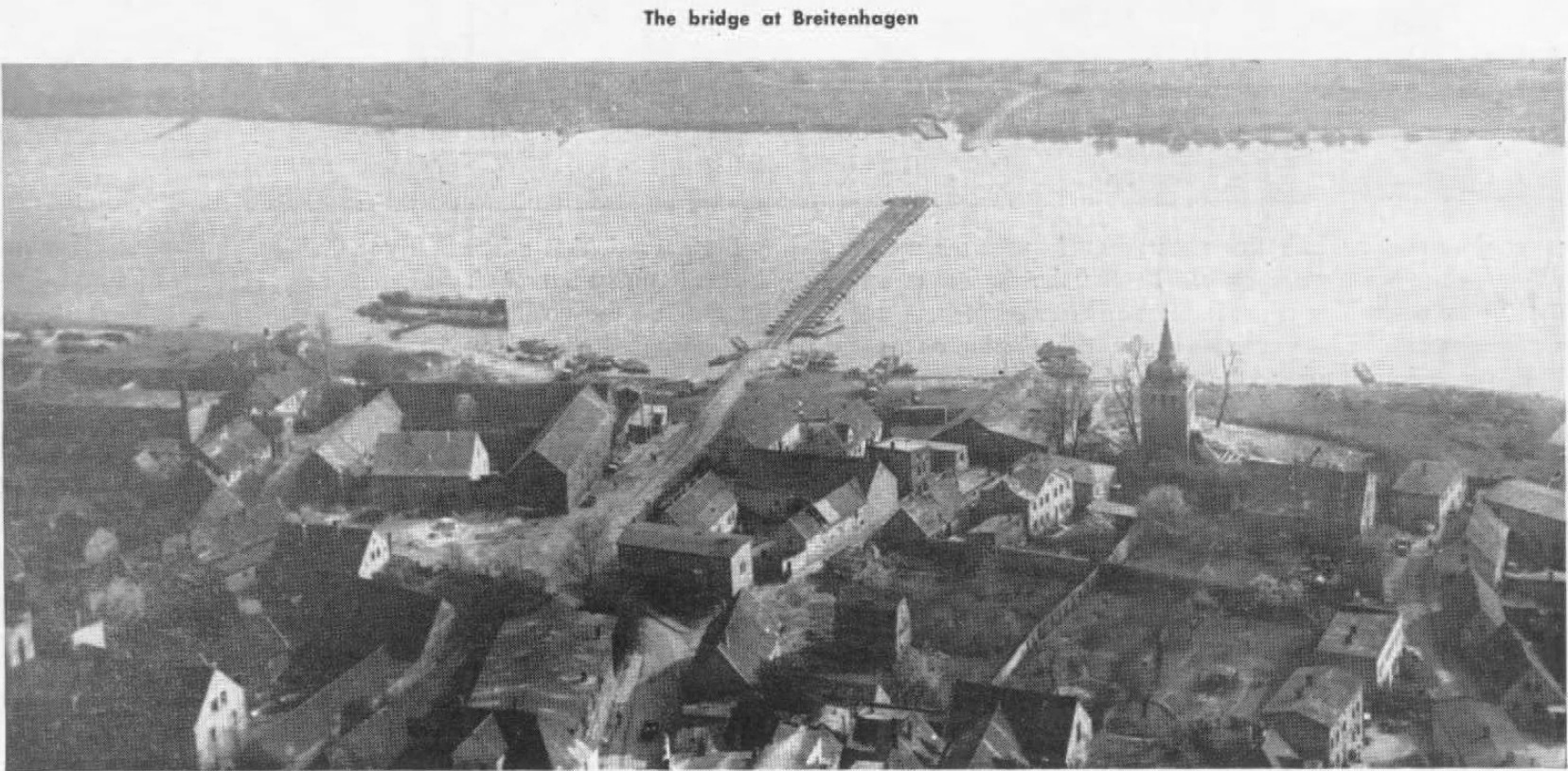
“Early in the afternoon of 13 April the engineers had 25 feet more to go to reach far shore, with sufficient floors constructed on the near shore to complete the bridge. At this opportune time, another heavy concentration of artillery fire started to fall scoring a Direct hit on the furthermost (east) section of the bridge, three other floats further back were knocked out, and the floats along the bank, that were ready to move into position, were also punctured. One of the power bouts, used to pull pontoons into position, was also hit and sank immediately. Adding to this a direct hit was scored on an adjacent anti-aircraft gun position, killing the crew, and knocking out the gun. (source: Oldhickory30thcom) *(the village “Breithagen” is not correct, this should be “Westerhüsen”).
11-2020
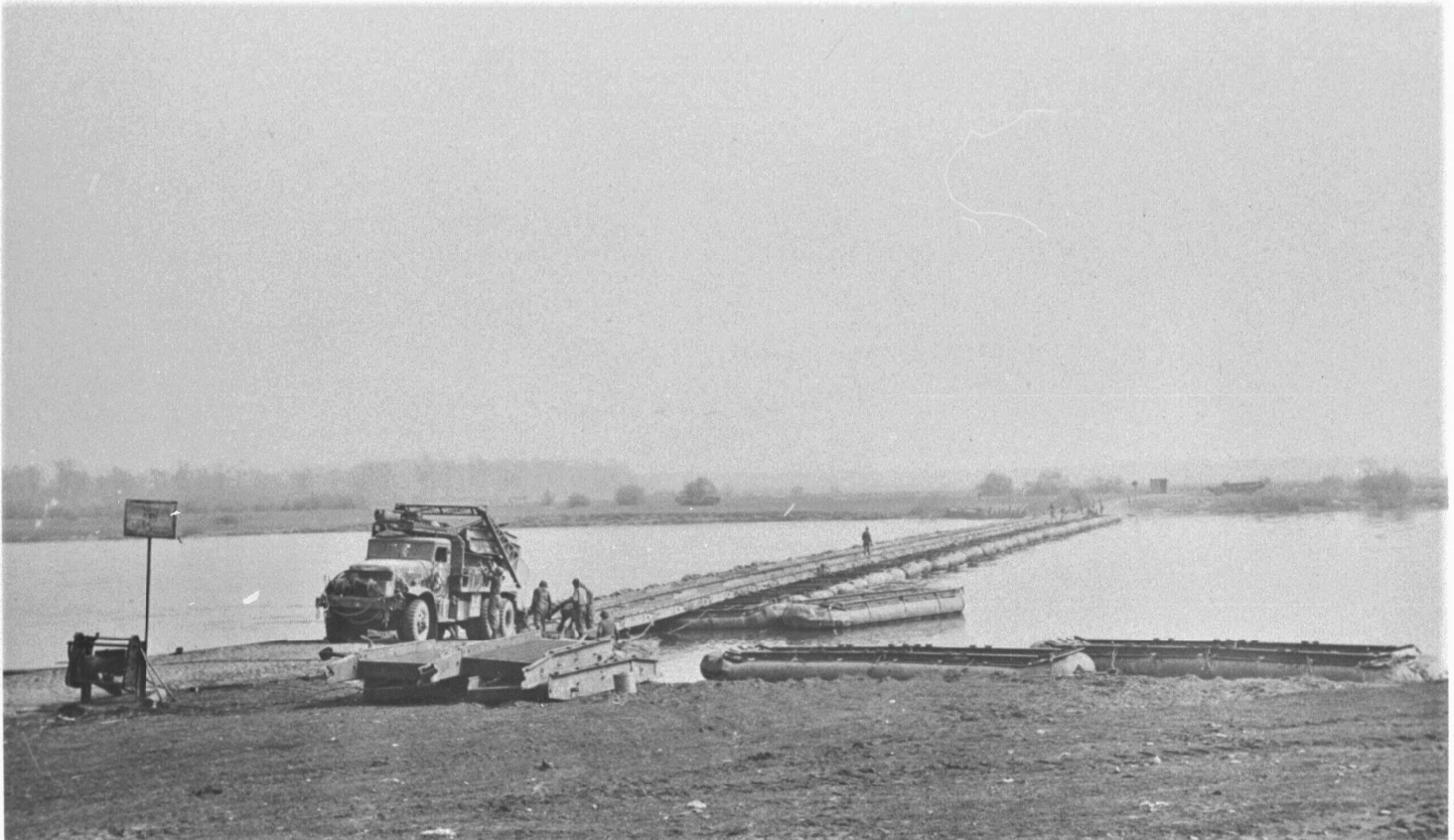
“Ninth U.S. Army crosses the Elbe.
Engineers pf the Second Armored Division, Ninth U.S. Army, work under direct enemy 88mm. gunfire on a pontoon bridge across the Elbe River near Magdeburg, Germany. April 14, 1945, the Ninth U.S. Army crossed the Elbe, the last water barrier before Berlin, and established two bridgeheads on the east bank. Magdeburg was stormed by Ninth Army forces on April 17, 1945″ (Source: NIOD, Holland)
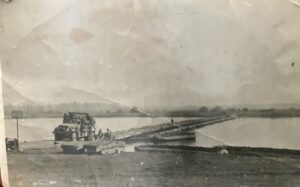
Elbe crossing April 13 – 15 1945 send home by Mastersergeant Daniel B Jolliff – Courtesy Rob Jolliff
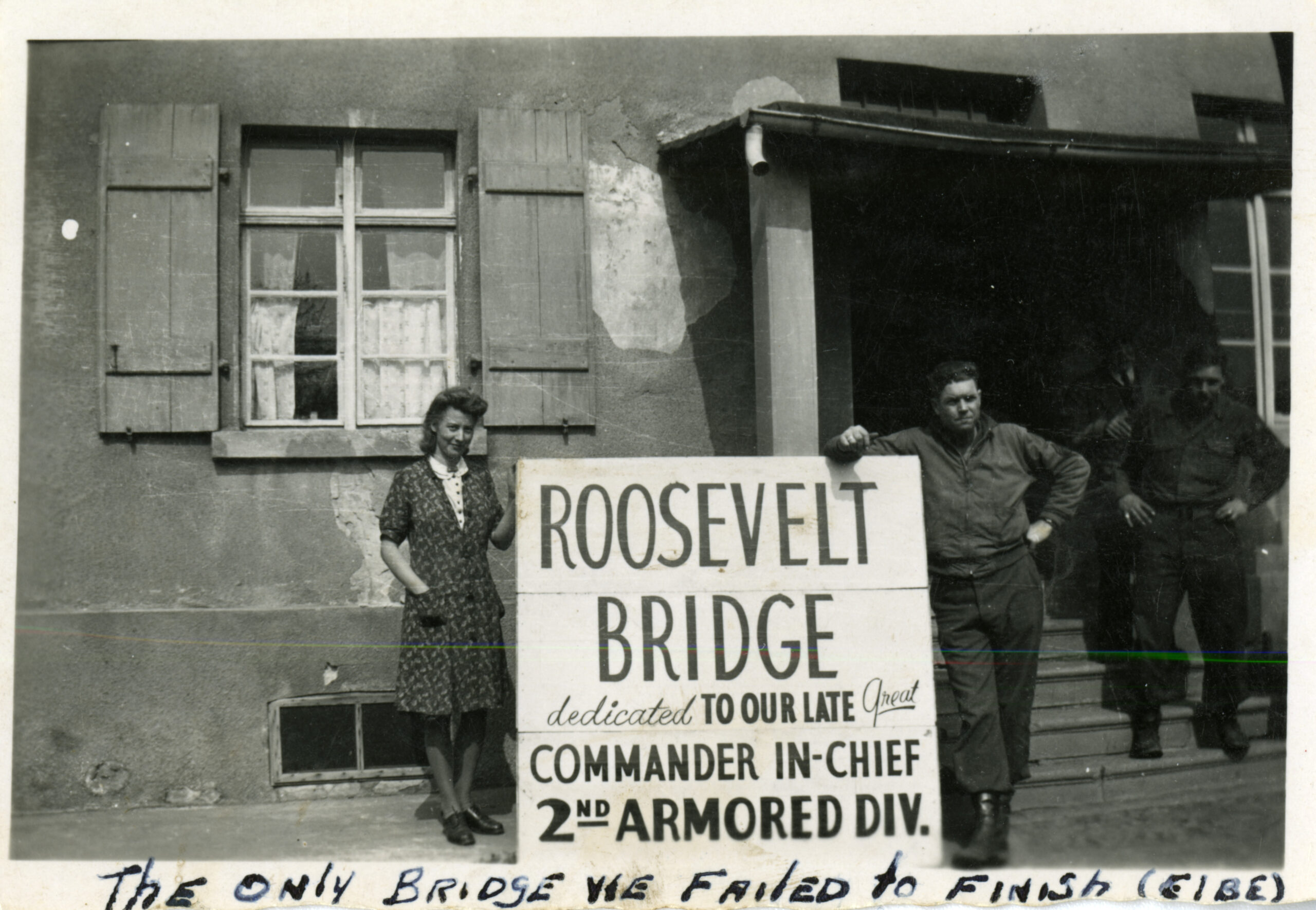
Roosevelt Bridge “The only bridge we failed to finish (Elbe) send home by Mastersergeant Dan B Jolliff – Courtesy Rob Jolliff
American serviceman and a German woman posing with a sign that reads
“Roosevelt Bridge dedicated to our late great Commander in-chief 2nd Armored Div.” another serviceman is standing on the steps of the building in the background. Personal caption on front: “The only bridge we failed to finish (Elbe). ” Westerhusen, Germany. April 1945. (Courtesy of Rob Joliff and ww2online.org)
Constructed by:
17th Armored Engineer Battalion, Company D, construct the bridge with Company E, equipment and the 82nd Engineers to furnish assault boats for the crossing of Infantry
Date:
13-14 april 1945
Build in time:
Two days, unfinshed
Start at 1045 Friday the 13th april
Abort constructing at 1400 on 14th april
12 April the Battalion (Plus) moved to Oschersleben, Germany (D4187) and again to Gr. Ottersleben, Germany (D6494). Here Company Dog and Company Easy started construction of a bridge across the Elbe River south of Magdeburg D703925 *at 2300B. The bridge construction was stopped at 0600B, 13 April by artillery fire, was resumed later at 10.45 and stopped again at 1245B the same day by intense artillery fire. This site was abandoned at 1400 and a large portion of the floats were damaged. The bridge lacked only 36 feet being completed
Length:
560 feet of Treadway.
Place:
Elbe river, at Westerhusen, five miles south of Magdeburg
((r)D703925 * original map location from the After Action report in google maps: 52°04’00.3″N 11°40’47.4″E)
Current location:
(r)D703925 * original map location from the After Action report in google maps: 52°04’00.3″N 11°40’47.4″E
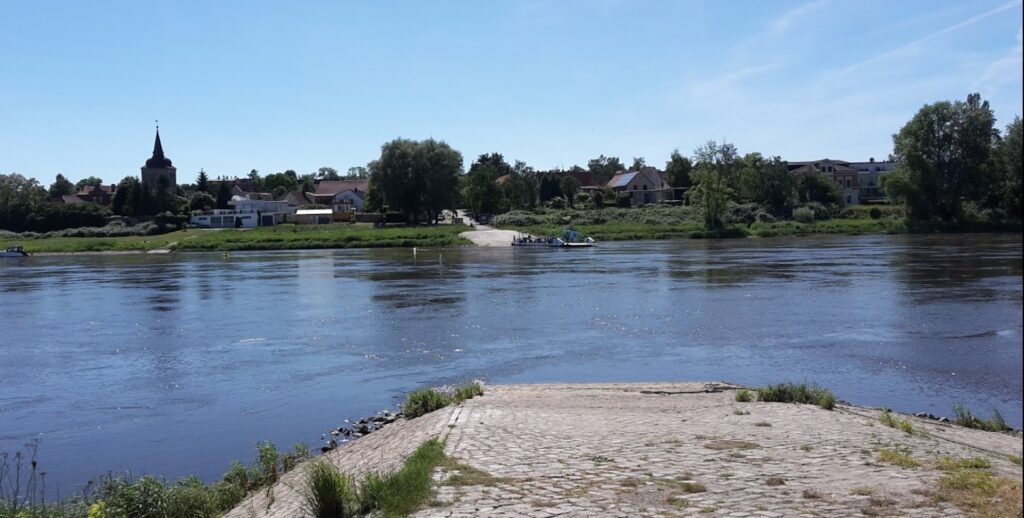 Current location at Westerhusen, Germany crossing on 13 – 14 April 1945
Current location at Westerhusen, Germany crossing on 13 – 14 April 1945
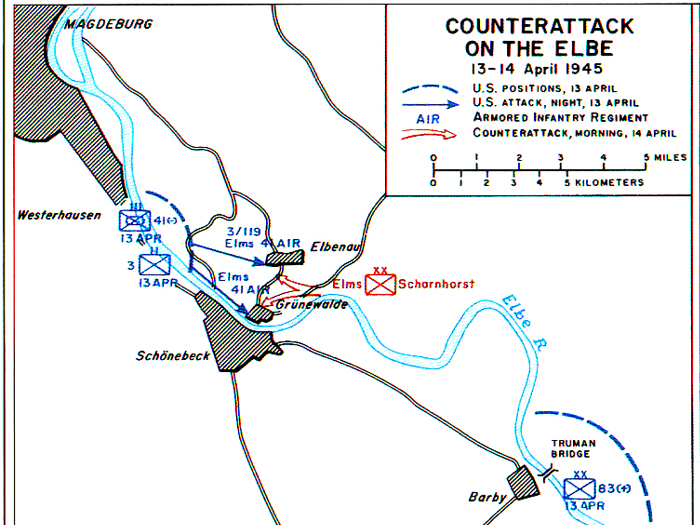 Attack at Westerhusen 13 – 14 April 1945
Attack at Westerhusen 13 – 14 April 1945
Information from the Unit History
Combat Command “B” was given the mission of making a bridgehead across the Elbe River south of Magdeburg. The city had not been taken, was known to contain numerous AA guns, otherwise was believed to be lightly defended. The site of the bridging operation was decided en, after a reconnaissance by Captains Youngblood (“D” Co.) and McAdams (“E” Co.) at a ferry landing by the town of Wester Husen, five miles south of Magdeburg. The Plan was for Co. “D” to construct the bridge with Co. “E” equipment and the 82nd Engrs to furnish assault boats for the crossing of Infantry.
With the Bridge Co and Bn Hq at Gr Ottersleben, four miles from the site, preparatory work was carried out there the night before the operation: floats were blown up, saddles attached, and were loaded on dump trucks, 15 having ben furnished by the 82nd Engrs, Lt. Col. Correll moved his CP into Wester Husen, all of “D” Co assembled there, and “E” Co moved its equipment into town. During the afternoon of 12 April enemy- artillery began a sporadic shelling of the site which lasted through the night. AA and indirect tank fire, obviously observed, continued harassing, and when the bridging operation began, was intensified.
Assembling of the Infantry (1/41) took more time than had been planned on, and it was 1000 when they began crossing. At 1045 Friday the l3th work began on the bridge. Two raft construction sites were manned by the 1st and 3rd Platoons of Co. “D” plus one squad from the 2nd Platoon; the other two squads, under Lt. Hillenbrand, were at the bridge assembly site. Organization for the job was continually interfered with by the incoming artillery, but the job was gradually reaching out front shore. Work proceeded through the afternoon and night, until 0600 when a heavy barrage forced everyone to take cover. Three floats near shore were completely destroyed, and two hours later, when work was resumed, floats near shore that were destroyed were deflated, removed, and others inserted. Other intense barrages called halts to the work later in the morning. Several of the workers were blown off a float by shell blast, but returned to the job. Probably the most distinguished act of heroism was that of Pfc Leo E. Rinkel of Co. “E” who by himself evacuated several wounded soldiers from the far shore by two trips with the power boat under heavy fire. With the precariousness of the situation fully realized by higher headquarters, when the crews started back to the site at 1400 they were told that the job was called off. By this time 560 feet of tread way had been laid, extending to within a short distance of the far shore, but the finished portion held at least five punctured floats.
Information from:
“the Official After action report from April 1st, 1945 to april 30th, 1945“
12 April the Battalion (Plus) moved to Oschersleben, Germany (D4187) and again to Gr. Ottersleben, Germany (D6494). Here Company Dog and Company Easy started construction of a bridge across the Elbe River south of Magdeburg D703925 * at 2300B. The bridge construction was stopped at 0600B, 13 April by artillery fire, was resumed later and stopped again at 1245B the same day by intense artillery fire. This site was abandoned and a large portion of the floats were damaged. The bridge lacked only 36 feet being completed.
* D703925 * original map location in google maps: 52°04’00.3″N 11°40’47.4″E
Information from: the Distinctive Unit Citation 17th Engineers, Easy Company
Later during the attempted crossing of the Elbe River, the heroism and complete devotion to duty demonstrated by each individual in refusing to abandon the project, even when the bridge was repeatedly destroyed by enemy fire, reflect great credit upon the organization and are in keeping with the highest traditions of military service.
Information Wikipedia:
At 11:00 p.m. on April 11th, an enemy alarm was given for Magdeburg , US units had advanced to the outskirts of Ottersleben . [70] This came as a relatively surprising surprise to the population, since the advance of American troops had taken place very quickly. The Wehrmacht report reported on the evening of April 11 of the advance of American troops in the area north and south of Hanover , [71]so clearly more than 100 kilometers west of Westerhüsen. In fact, the U.S. troops had covered about 90 kilometers during April 11 and had reached Schönebeck and the western suburbs of Magdeburg. On the evening of April 11, the Americans made their way to Magdeburg airfield . According to a report, the Diana forced labor camp on the western edge of Westerhüsens was also reached on April 11, shortly after the enemy alarm was given. [72]
On April 12, 1945, American units, coming from the west via Wolfsfelde , initially advanced to Salbke and thus reached the west bank of the Elbe. Everyday things like newspaper delivery are said to have been normal until April 11th. The US troops occupied the west bank of the Elbe and thus Westerhüsen without much resistance. They also moved into the villages of Sülldorf , Dodendorf , Osterweddingen and Sohlen and made contact with the US troops involved in the fighting in Schönebeck.
Information spread among the population and among the liberated foreign and forced laborers that south of Westerhüsen in the silos at the entrance to Schönebeck – Frohse there was a food warehouse of the Wehrmacht. Many people went there to get food. German snipers are said to have opened fire from the east bank of the Elbe. 19 people are said to have been shot.
The American troops decided to quickly cross the Elbe near Westerhüsen near the Westerhüsen ferry and to form a bridgehead on the east bank. The operation was delayed due to logistical problems. Instead at 18.30 it was finally ended at 21.30 with assault boats through. Tanks and tank destroyers secured the crossing in Westerhüsen. There was no resistance at first. The troops above formed a semicircular bridgehead of about one kilometer in length on the Prinzenwiese . Already around midnight two battalions were transferred, another followed. American pioneer units started a pontoon bridge around 10:45 p.m.to build. The corresponding components had been prefabricated in the Ottersleben area . There were isolated German artillery fires. In the early morning of April 13, shelling at the bridge construction site intensified and became more precise. [73] The impacts came over a few hundred meters up the river to the construction site. [74] While the American troops expanded the bridgehead and advanced through the Kreuzhorst to Pechau and took Randau without a fight, the bridge construction continued. Heavy artillery shelling, probably from Magdeburg flak artillery, hit eight meters before reaching the east bank, [75]the bridge. The eastern end was destroyed in no time. The shelling then targeted specific US facilities on the west bank. The artillery attack was apparently directed by a control center with complete insight into the translation point, without the Allies being able to locate the observation post. The American troops searched all of the riverside houses in Westerhüsens, but to no avail. [76]Due to bad weather conditions, the location of the artillery could not be determined. The construction work was interrupted and then continued from 9:00 a.m. to 11:30 a.m. Artillery shells hit the bridge again, this time on both sides. Several US soldiers died and most of the floating bridge parts were destroyed. Artificial smoke screens produced by US pioneers using smoke pots on both banks also had no effect. [74] Around 2 p.m. an attempt was made to resume construction. However, there was another heavy attack. [77]In a short time, both Bugsier boats, the bridge parts ready for construction on the west bank and an American anti-aircraft gun were destroyed. Several soldiers lost their lives in the process. Allied efforts to break the bridge were stopped and the remaining pioneering equipment was evacuated under constant fire. The US troops in the bridgehead, which had been hit by German troops coming from Gommern , were then largely moved south towards Schönebeck. German troops from Gommern attacked the US troops that had advanced to Elbenau . After fighting in the Elbenau and Grünewalde area, the US bridgehead ultimately had to be cleared by the US troops. [78]German units advanced north from there and again occupied the banks of the Elbe opposite Westerhüsen. The remains of the raft bridge were destroyed with bazookas and explosive charges. [79] 220, according to US data, 350 US soldiers were captured in the fighting for the bridgehead. [80] Only with the later entry of Soviet troops into the Magdeburg districts east of the Elbe did the warfare stop there as well.
Information Newspapers:
Article about Co E, 17th Armored Engineer Battalion from Paper Hell on Wheels June 13 1945 Photo.( Courtesy Dave Ketchpaw):
Exerpt from Article:
The next job was the Elbe, and south of Magdeburg Companies “D” and “E” worked under intense artillery fire, well zeroed in, to build 560 feet of bridge and almost reach the far shore before work was stopped.
SATURDAY, APRIL 14, 1945
SECOND ELBE CROSSING—The 9th Army today won a new bridgehead across the Elbe. An un-official source placed the new crossing at Barby (small arrow). The 3d Armored Division advanced up to 30 miles to within 3 miles of Dessau. Shaded portions show the Allied and Russian squeeze on Berlin. Large arrow marks the first crossing of the Elbe.
Yanks 18 Miles From Czech Border
[Continued From Page 1] half of her 58 cities of more than 100,000 population. British Gains In North The British 2d Army cut loose in the north in an advance to Uelsen; 49 miles southeast of Hamburg. The Canadians fought to within seven miles of the North Sea and onto the approaches of Emden. The Hell on Wheels 2nd Armored Division of the 9th Army had established a firm bridgehead over the Elbe in the Magdeburg area, 97 miles from the capital and was progressing slowly. The 17th Engineers Corps was forced to proceed slowly with bridging the 450-foot river because the Germans had the site under direct observation and heavy artillery fire. The 5th Division north of Magdeburg was closer to Berlin-45 miles away. Bridging the Elbe presents even greater difficulties than the Roer or Rhine Associated Press Correspondent W. Gallagher said. The main fire on the bridge, head came from the flak batteries.
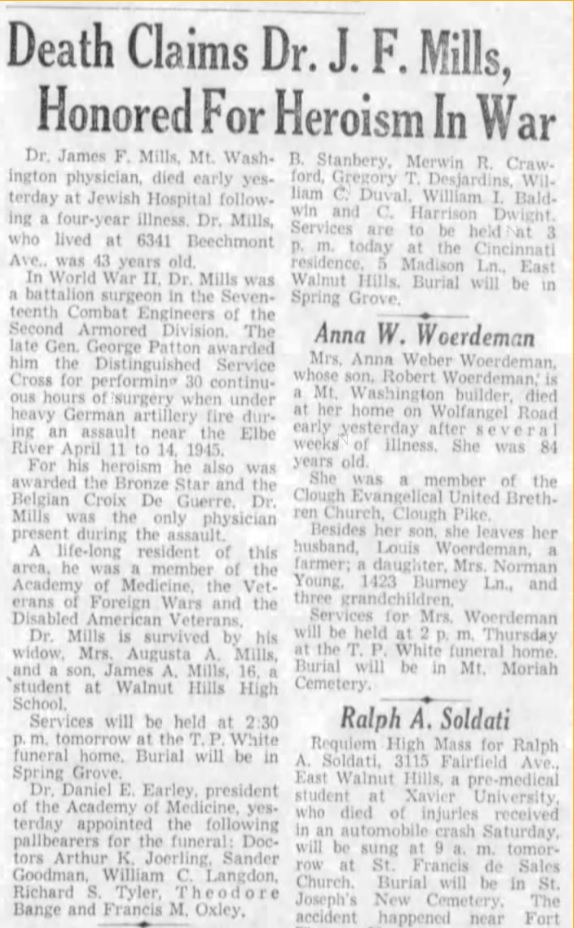
Sergeon James F Mills The Cincinnati Enquirer (Cincinnati, Hamilton, Ohio, United States of America) · 4 Aug 1953
Death Claims Dr. J. F. Mills, Honored For Heroism In War
Dr. James F. Mills, Mt. Washington physician, died early yesterday at Jewish Hospital follow-ing a four year illness. Dr. Mills, who lived at 6341 Beechmont Ave, was 43 years old. In World War II. Dr. Mills was a battalion surgeon In the Seventeenth Combat Engineers of the Second Armored Division. The late Gen. George Patton awarded him the Distinguished Service Cross for performlne 30 continu-ous hours of surgery when under heavy German artillery fire during an assault near the Elbe River April 11 to 14, 1945. For his heroism he also was awarded the Bronze Star and the Belgian Croix De Guerre. Dr. Mills was the only physician present during the assault. A life-long resident of this area, he was a member of the Academy of Medicine, the Veterans of Foreign Wars and the Disabled American Veterans, Dr. Mills is survived by his widow, Mrs. Augusta A. Mills, and a son, James A. Mills, 16, a student at Walnut Hills High School. Services will be held at 2:30 p. m. tomorrow at the T. P. White funeral home, Burial will be in Spring Grove. Dr. Daniel E. Earley, president of the Academy of Medicine, yesterday appointed the following pallbearers for the funeral: Doctors Arthur K. Joerling, Sander Goodman, William C. Langdon, Richard S. Tyler, Theodore Binge and Francis M, Oxley,
R. Stanbery, Merwin R. Craw-ford, Gregory T. Desjardins, C Duval, William I. Bald-win and C. Harrison Dss lent. Services are to be held at 3 p. m. today at the Cincinnati residence, 5 Madison ln., East Walnut Hills. Burial will be in Spring Grove.

Dr J Mills – The Cincinnati Enquirer (Cincinnati, Hamilton, Ohio, United States of America) · 28 Sep 1945
SURGEON Is Cited For Heroism
At Advance Station Near Elbe River Crossing.
Three Other Greater Cincinnati Veterans Are Presented With Bronze Stars.
Bronze Star medals for “heroic action” have been awarded to two Cincinnatians, for service in Europe and the Pacific. Capt. James F. Mills, 6341 Beech, mont Ave., Mt. Washington, who was battalion surgeon of the 17th Combat Engineers of the Second Armored Division, a Ninth Army unit, was cited for his courage in reconnoitering for and establishing a forward aid station on the west bank of the Elbe River near the site of a proposed bridge. Th action took place April 11-14 before and during the assault across the Elbe south of Madgeburg and 12 miles from Berlin. “He organized his detachment and planned his evacuation routes for the immediate handling of casualties,” the citation reads. “While primarily designed to care for engineer casualties, the lack of other similar facilities forced Captain Mills and his men to care for infantry, anti aircraft and other f casualties as well as their own men.
“EXAMPLE TO MEN”
“Captain Mills, who was the only medical officer present, worked for 30 hours at a stretch, directing his men and performing as much surgery as the limited means al lowed. He coolly continued his work under Intense artillery fire, exposing himself where necessary to direct evacuation or to administer immediate aid. His leadership and professional , ability were an example to his men who never faltered. Besides his Bronze Star, Captain Mills is entitled, to wear the red-and-green cord looped over the shoulder which signifies the award of the Four de Guerre by the Belgium government to the Second Armored Division. The Second is the only foreign outfit to receive this award. Gen. George S. Patton, the Second’s original commanding officer, sent a personal letter of congratulation to his successor on the division’s successful crossing of the Rhine in 10 hours. The Captain wears four battle star also on his theater ribbon. “Progress in medical science is the only good resulting from war,” Captain Mills said, “but the Jeep was Hitler’s secret weapon.” Describing another aspect of the al most unanimously praised little buggy, he told how one hospital visited had half its beds filled with victims of Jeep accidents.
Information from interview: 17th Engineer Ralph Kephardt (source: The Courier (Waterloo, Iowa, United States of America) · 15 Dec 2014)
……his closest call came a short time later, when German artillery shot up and sunk their bridge as troops were about to cross the Elbe River. Two companies of U.S. troops who had already crossed had to be retrieved by boat to be saved from the Germans. Many were. Some weren’t. During the artillery barrage,
Kephardt and a buddy, taking cover under their trucks, decided to make a break for a stone house they thought would provide better shelter. “We got to the door of that house, and an explosion blew us both right into the house. In fact, it blew me over the top of him;’ Kephardt said. “We stayed in that house and they hit that house two or three times and we decided we’d better get out of there They and two other comrades taking shelter grabbed a truck and escaped. Kephardt said he took a piece of shrapnel in his head but never sought a Purple Heart. “It didn’t hurt me. It just burned,” he shrugged. “That was the worst deal I ever got into. They just blew hell out of stuff!” His unit withdrew several miles to be reequipped and returned to the same crossing — only to now find it occupied by Soviet troops who had advanced upon the Germans from the other direction…….
Read more here about 17th Engineer Ralph Kephart: The story of Ralph Edward Kephart
11-2020
Information from a newspaper article, the story of a Hitlerjugend soldier during 12 -17 april 1945
A contemporary witness reports: The last contingent
In April 1945, nests of resistance were created in the various outlying districts of Magdeburg. There we 15- to 16-year-old Hitler Youths and a handful of older Volkssturmmanners in SchOt-zenlochem on the Magdeburg “Western Front” between the western cemetery and the former Enke barracks. On the other hand, the 9th US Army was equipped with modern military equipment, was numerically superior and was also supported by fighter-bombers, who mainly dropped cluster bombs. At regular intervals, shells struck us. Then we had the first dead. Hans-Joachim Plumecke, the
was home only a few hundred yards away. But the fight continued, even when the first Sherman tank appeared on the green belt of today’s neighboring settlement. A very brave one even fired a bazooka at him. In return we received fire from the tank turret. The fighting continued well into the night before American tanks and jeeps advanced to the west ring. On our side there were further losses, and an old friend, Gunter Pratorius, owed his life to a spontaneous reaction and a little luck, while the man in front was struck down by a volley. A comrade and I stood guard at our post until a veteran sergeant chased us home without further ado. One for all of us
dangerous decision. But even in war there is a bit of humanity, which was then repeated. when two GIs came into our apartment looking for weapons and escaped soldiers. When I opened the door, nothing better than to greet them both with a “How do. You do”. When they saw my four-month-old Snider in his chair, only the baby was of interest. Both soldiers ran away us, but came back once more: the hands full of groceries, including dried milk. Then we realized that the war was over for the suffering Magdeburgers. We got away again.
H. Blaitke
11-2020
Information document written by Lt. Houcek called the “Elbe Operation
with 2d Armored Division & 83d Infantry Division”
(Exeprts concerning 17th Armored Engineer Battalion)
……The 3d Battalion, 41st Armored Infantry, under the command of Lt Col Arthur J. Anderson, had been
in the process of cleaning up Schonebeck on the evening of 12 April, when orders were received to
move to Westerhusen. Upon arrival they received instructions to cross the river and secure the right
flank of the bridgehead. Elements of the 3d Battalion started across the river in DUKWS at
approximately 2230, completing the relief of A Company, 41st AIR early the next morning—-The engineers having ferried the better part of two battalions across the river by 2300, began
construction of the proposed bridge. Companies D and E, 17th Armored Engineer Battalion, had
been selected for this job. Being terribly dark, the engineers had difficulty seeing even with the aid of two search lights beamed over the site to give artificial moon light. This failed to enlighten the situation for there were no clouds in the sky to reflect the light, the light, thebeams simply dissipated in the sky. Even though being hindered by lack of light, work progressedrather rapidly from then until daylight without any unusual incidents, other than a few rounds of harassing artillery fire.
……At 0200, 13 April, 1st Battalion, 41st Armored Infantry Regiment sent a patrol to determine whether the bridge across the Alte-Elbe River at (D724943) was intact. The patrol reached (D714943) where it surprised and captured an enemy outpost of six Germans, arriving back at the battalion command post a short time later.
With the light of day edging over the horizon, 0530, the engineers put smoke pots on both sides of the river, above and below the bridge site to screen the operations from enemy observation. Having experienced intermittent artillery fire throughout the night, the incoming artillery became more active as the day grew lighter. A heavy concentration of indirect and direct fire was received around 0600 from the high ground directly opposite the bridge site, destroying five floats on the bridge.
Considerable fire was also received from the area on the east bank of Magdeburg, destroying a number of floats already constructed on the bank, awaiting to be ferried to the bridge. It was thus necessary to suspend operations temporarily, about an hour, due to the intensity of fire coming in. During this same period, our artillery fired countless counter-battery missions with meager results; for after the work again began, enemy artillery was still falling, although not quite as heavily.
Lt Col Louis W. Correll, Division Engineer, said, “The smoke wasn’t too effective because the enemy had observation from different directions. The smoke, although, wasn’t too dense, it may have blocked out observation from some spots but I’m certain there were many other points of vantage that could be used for the same purpose.”“…..Early in the afternoon of 13 April the engineers had 25 feet more to go to reach far shore, with sufficient floors constructed on the near shore to complete the bridge. At this opportune time, another heavy concentration of artillery fire started to fall, scoring a Direct hit on the furthermost (east) section of the bridge, three other floats further back
were knocked out, and the floats along the bank, that were ready to move into position, were also punctured. One of the power bouts, used to pull pontoons into position, was also hit and sank immediately. Adding to this a direct hit was scored on an adjacent anti-aircraft gun position, killing the crew, and knocking out the gun.
Operations were suspended for the second time while our artillery tried to neutralize the enemy fire. After a 30 minute recess, an attempt was again made to repair and continue construction of the
bridge; however, obviously under observation, as the work party moved to the bridge site, a heavy and continuous concentration was placed on the bridge and area adjoining. The second power boat, of which there were only two, was knocked out as were a number more floats on the bridge.
As Correl phrased it. “They just continued to throw heavy concentrations all over the bridge site. So much was coming in, the Forward Observers just couldn’t locate it. Haze, covering the high ground of the bridgehead area, prevented air observers from locating the gun positions, and counter-battery fire seemed to have little or no effect on the enemy artillery.” At one tine, a man walked out on the bridge to check the damage and immediately 22 rounds of artillery were fired in on him. Fortunately, he wasn’t hurt.By 1400, a large portion of all the available bridge equipment had been knocked out when Col Correll received orders from Gen Hinds the t the bridge would be abandoned. Immediately orders were issued and the engineers began pulling out all the trucks and equipment to prevent further damage, as the fire continued to roll in.”
…….At 0300, Combat Command B received an order from the 2d Armored Division CP to leave a covering force on the east bank of the river at the abandoned bridge site, although all elements of the command had already been displaced to the south upon receipt. However, one squad of
Company D, 17th Armored Engineer Battalion was ordered to cross the river and establish that security, although unable to cross the river because the enemy already held the east bank. The engineers were ready to start construction of a pontoon bridge at the net proposed site (D735891) me soon as practical. This plan shortly proved impossible for the enemy had retaken the river area at the proposed site after the bridgehead troops had cleared it. At 0640, the town of Grunewalde being cleared, construction of a ferry site (D749881) was begun at once by the 82d Engineer Battalion.……The 82d Engineer Battalion, all this time, had been feverishly working against time on the damaged cable and ramp. At 1205, the construction and repair work had been completed and the dozer, needed for construction of a ramp on the far shore, was loaded. In spite of the approach ramp on the near bank, the river was still too shallow to float the ferry when loaded and was grounded unable to pull off under its own power. With external force it was freed and began its first trip with
progress very slow because of the swift current. A DUKW driven to the ferry by Capt Youngblood, CO, Company D, 17th Armored Engineer Battalion, was lashed to the floats to increase the propelling power. Progress immediately improved, but yards before reaching the east bank, an artillery barrage came in and cut the guide cable. The swiftness of the river and the absence of the guide cable made it impossible to control the ferry with the power of two outboard motors and the DUKW, thus the ferry drifted downstream lodging against the debris of the old blown bridge. More artillery began to fall in the vicinity of the bridge and upon Capt Youngblood’s orders, the DUKW was cut loose and all personnel of the ferry and the bulldozer were evacuated.
07-2021
Full Article:
ELBE OPERATION by Lt. Houcek
Office of the Chief of Military History (OCMH; now US Army Center of Military History); Historical Manuscripts Collection (HMC) under file number 8-3.1 AM
Research M. Brandjes 2019, edited november 2020, july 2021 Martijn Brandjes and Arjen Kok.
